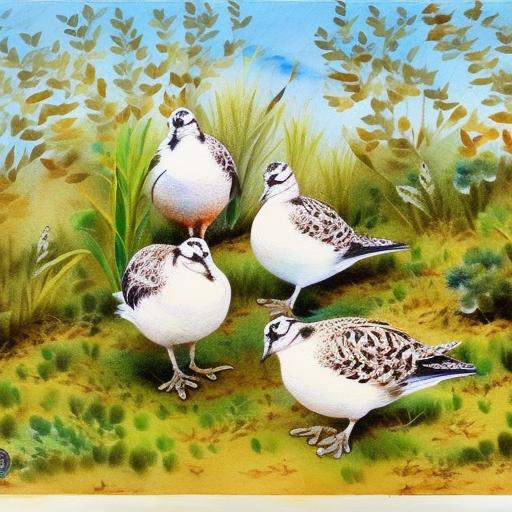White quail, also known as Coturnix quail, are a popular breed of quail that are known for their small size, gentle nature, and delicious meat and eggs. They are a domesticated breed of quail that have been selectively bred for their white plumage, making them a popular choice for backyard poultry enthusiasts and small-scale farmers. White quail are easy to care for, adaptable to various climates, and can be raised in small spaces, making them an ideal choice for those looking to raise poultry for meat and eggs. In this article, we will explore the characteristics and appearance of white quail, popular white quail breeds, care and housing for white quail, breeding and reproduction of white quail, health and wellness of white quail, and tips for raising white quail.
Key Takeaways
- White quail breeds are a popular choice for backyard poultry enthusiasts due to their small size and low maintenance requirements.
- White quail are known for their compact size, round bodies, and distinctive white plumage, making them a visually appealing addition to any flock.
- Popular white quail breeds include the Texas A&M, English White, and Tibetan quail, each with their own unique characteristics and traits.
- Proper care and housing for white quail includes providing a secure and spacious enclosure, a balanced diet, and protection from predators and extreme weather conditions.
- Breeding and reproduction of white quail requires careful monitoring of nesting boxes, egg collection, and providing a suitable environment for hatching and raising chicks.
Characteristics and Appearance of White Quail
White quail are small birds, typically measuring around 7-8 inches in length. They have a plump, rounded body with a short tail and small head. Their most distinctive feature is their white plumage, which sets them apart from other quail breeds. White quail have a gentle and docile nature, making them easy to handle and care for. They are also known for their high egg production, with hens laying up to 300 eggs per year. In addition to their egg-laying abilities, white quail are also raised for their meat, which is lean and flavorful. Overall, white quail are a versatile and productive breed of poultry that are well-suited for small-scale farming and backyard homesteading.
White quail have a distinctive appearance that sets them apart from other quail breeds. Their white plumage is a result of selective breeding, and they have a plump, rounded body with a short tail and small head. They are known for their gentle and docile nature, making them easy to handle and care for. In addition to their friendly disposition, white quail are also highly productive, with hens laying up to 300 eggs per year. Their meat is lean and flavorful, making them a popular choice for those looking to raise poultry for both eggs and meat. Overall, white quail are a versatile and productive breed of poultry that are well-suited for small-scale farming and backyard homesteading.
Popular White Quail Breeds
There are several popular breeds of white quail that are commonly raised for their meat and eggs. One of the most popular breeds is the Texas A&M quail, which is known for its high egg production and fast growth rate. Another popular breed is the English White quail, which is prized for its large size and excellent meat quality. The Jumbo White quail is another popular breed that is known for its rapid growth and large size. These breeds are all well-suited for small-scale farming and backyard homesteading, and each has its own unique characteristics that make it a popular choice for those looking to raise white quail.
In addition to the Texas A&M, English White, and Jumbo White quail breeds, there are several other popular breeds of white quail that are commonly raised for their meat and eggs. The Italian White quail is known for its high egg production and gentle nature, making it a popular choice for backyard poultry enthusiasts. The Tibetan White quail is another popular breed that is prized for its large size and excellent meat quality. These breeds are all well-suited for small-scale farming and backyard homesteading, and each has its own unique characteristics that make it a popular choice for those looking to raise white quail.
Care and Housing for White Quail
White quail are relatively easy to care for and can be raised in a variety of housing setups. They can be kept in small cages or aviaries, or they can be free-ranged in a secure outdoor area. When housing white quail, it’s important to provide them with plenty of space to move around, as well as access to fresh water and a balanced diet. They should be provided with a high-quality game bird feed that is specifically formulated for quail, as well as access to grit to aid in digestion. Additionally, white quail should be provided with shelter from the elements, as well as protection from predators such as cats, dogs, and birds of prey.
When caring for white quail, it’s important to provide them with plenty of space to move around, as well as access to fresh water and a balanced diet. They should be provided with a high-quality game bird feed that is specifically formulated for quail, as well as access to grit to aid in digestion. Additionally, white quail should be provided with shelter from the elements, as well as protection from predators such as cats, dogs, and birds of prey. They can be kept in small cages or aviaries, or they can be free-ranged in a secure outdoor area. Overall, white quail are relatively easy to care for and can be raised in a variety of housing setups.
Breeding and Reproduction of White Quail
Breeding white quail is relatively straightforward, and they are known for their high fertility rates. To breed white quail, it’s important to provide them with a suitable nesting area that is dark and secluded. Hens will lay their eggs in the nesting area, and they should be allowed to brood naturally or the eggs can be collected and placed in an incubator. White quail eggs typically hatch within 17-18 days, and the chicks are relatively easy to raise. They should be provided with a warm brooder area and access to chick starter feed, as well as plenty of clean water. With proper care and nutrition, white quail chicks will grow quickly and can be raised to maturity in just a few weeks.
Breeding white quail is relatively straightforward, and they are known for their high fertility rates. To breed white quail, it’s important to provide them with a suitable nesting area that is dark and secluded. Hens will lay their eggs in the nesting area, and they should be allowed to brood naturally or the eggs can be collected and placed in an incubator. White quail eggs typically hatch within 17-18 days, and the chicks are relatively easy to raise. They should be provided with a warm brooder area and access to chick starter feed, as well as plenty of clean water. With proper care and nutrition, white quail chicks will grow quickly and can be raised to maturity in just a few weeks.
Health and Wellness of White Quail

White quail are generally hardy birds that are resistant to many common poultry diseases. However, it’s still important to provide them with proper care and nutrition to ensure their health and wellness. Regularly cleaning their housing area and providing them with fresh water and high-quality feed will help prevent disease and keep them healthy. Additionally, it’s important to monitor their behavior and watch for any signs of illness or injury. If a white quail does become sick or injured, it’s important to seek veterinary care as soon as possible to ensure their recovery.
White quail are generally hardy birds that are resistant to many common poultry diseases. However, it’s still important to provide them with proper care and nutrition to ensure their health and wellness. Regularly cleaning their housing area and providing them with fresh water and high-quality feed will help prevent disease and keep them healthy. Additionally, it’s important to monitor their behavior and watch for any signs of illness or injury. If a white quail does become sick or injured, it’s important to seek veterinary care as soon as possible to ensure their recovery.
Tips for Raising White Quail
Raising white quail can be a rewarding experience, but it’s important to keep a few tips in mind to ensure success. Providing them with plenty of space to move around, access to fresh water and high-quality feed, shelter from the elements, and protection from predators will help keep them healthy and productive. Additionally, monitoring their behavior and watching for any signs of illness or injury will help ensure their health and wellness. Breeding white quail is relatively straightforward, but it’s important to provide them with a suitable nesting area that is dark and secluded. With proper care and nutrition, white quail can be raised successfully for meat and eggs on small-scale farms or in backyard homesteading setups.
Raising white quail can be a rewarding experience, but it’s important to keep a few tips in mind to ensure success. Providing them with plenty of space to move around, access to fresh water and high-quality feed, shelter from the elements, and protection from predators will help keep them healthy and productive. Additionally, monitoring their behavior and watching for any signs of illness or injury will help ensure their health and wellness. Breeding white quail is relatively straightforward, but it’s important to provide them with a suitable nesting area that is dark and secluded. With proper care and nutrition, white quail can be raised successfully for meat and eggs on small-scale farms or in backyard homesteading setups.
In conclusion, white quail are a versatile breed of poultry that are well-suited for small-scale farming and backyard homesteading. Their gentle nature, high egg production, delicious meat quality make them an ideal choice for those looking to raise poultry for meat and eggs. By providing them with proper care and nutrition, monitoring their health and wellness, breeding them successfully, raising white quail can be a rewarding experience for poultry enthusiasts of all levels.
In addition, their small size and low maintenance requirements make them a practical choice for those with limited space and time. Whether you are a beginner or an experienced poultry keeper, white quail can be a valuable addition to your flock. With their charming appearance and friendly disposition, they can also be a delightful addition to any backyard or small farm. Overall, white quail are a wonderful option for anyone looking to add a productive and enjoyable poultry species to their homestead.
If you’re interested in learning more about white quail breeds, you might also want to check out this article on what vegetables do quails eat. It provides valuable insights into the dietary preferences of quails and can help you ensure that your quails are getting the nutrition they need.
FAQs
What are some common white quail breeds?
Some common white quail breeds include the Texas A&M, English White, and Tibetan quail.
What are the characteristics of white quail breeds?
White quail breeds typically have a white plumage, with some variations in markings and coloration. They are known for their small size and gentle disposition.
What are the uses of white quail breeds?
White quail breeds are often raised for their meat and eggs. They are also popular as pets and for exhibition purposes.
What are the care requirements for white quail breeds?
White quail breeds require a suitable enclosure with proper ventilation, lighting, and temperature control. They also need a balanced diet and access to clean water.
Are white quail breeds suitable for beginners?
White quail breeds are generally considered to be suitable for beginners due to their small size and relatively low maintenance requirements. However, proper research and preparation are still necessary before getting started with raising quail.
Meet Walter, the feathered-friend fanatic of Florida! Nestled in the sunshine state, Walter struts through life with his feathered companions, clucking his way to happiness. With a coop that’s fancier than a five-star hotel, he’s the Don Juan of the chicken world. When he’s not teaching his hens to do the cha-cha, you’ll find him in a heated debate with his prized rooster, Sir Clucks-a-Lot. Walter’s poultry passion is no yolk; he’s the sunny-side-up guy you never knew you needed in your flock of friends!







